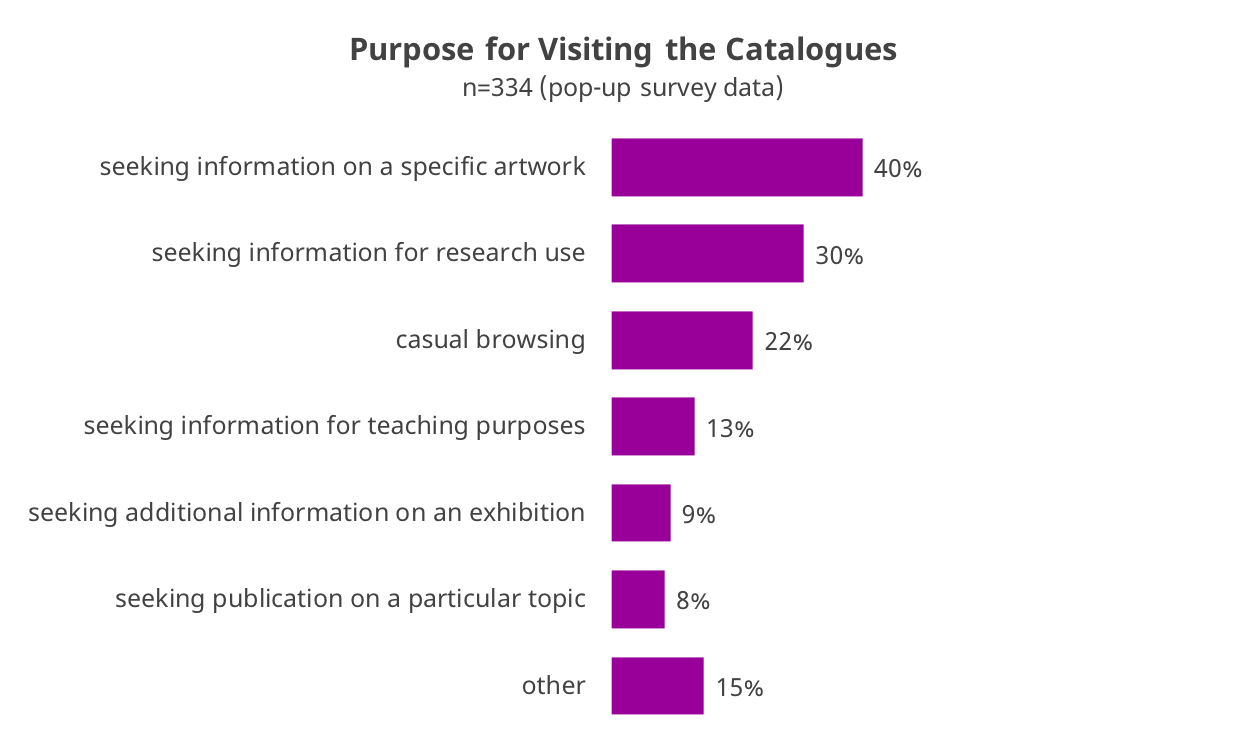Why do users visit the catalogues?
A key question for the team was whether users come to the catalogue because they are interested in the overall topic (e.g., Matisse, seventeenth-century Dutch painting) or if they are more likely to end up there while searching for information on specific artworks. The pop-up survey shows that the latter is the stronger driving force, accounting for 40% of participants. Only 8% of participants said their visit was driven by a topic interest.
Additionally, a handful of participants said they were looking for high-quality images, even if not searching for a specific piece. This finding corresponds with our focus group discussions, where most participants talked about their interest in specific pieces being the primary reason they might turn to a digital catalogue:1
I really go with a pinpointed reason why I’m looking up an entry on an artwork—when I want to really look for a comparative image that I’m working on. I want to have that possibility to zoom in and really look closely to make comparisons with the images. So I think I use it in a very kind of flexible, fluid kind of research. And I know it’s immediate, it’s accessible, it’s right there. And that’s one of the things that I love about using them.
That being said, one focus group participant commented that she usually turns to museum catalogues to investigate a specific artwork, which might then lead her to viewing other content in the publication:
So when I go to print catalogues, I’m looking for what’s been written most recently about a certain work of art. And also their bibliography that goes along with it so I can get the most up-to-date info that I can. I can imagine using digital catalogues much in the same way. And then letting the individual images that I’m looking for kind of lead me to the rest of the content.
Pop-up survey participants also wrote in additional reasons for visiting the catalogues, such as planning a visit to the museum, following up after a visit to the museum, and interest in digital catalogues as a resource (including several individuals who arrived at the catalogues via links from the OSCI final report).
Thirteen percent of the pop-up survey participants said they came to the catalogues seeking information for teaching purposes, and this aligned with focus group discussions as well. When asked how they could picture using the catalogues for their work, focus group participants repeatedly talked about teaching with the catalogues, and in a variety of ways:
I would use these as, as a teaching resource for sure… I felt that the scholarly content from some of them was really great and would be really appropriate for Masters- and PhD-level students.
I’ve also coincidentally assigned an Art Institute catalogue for reading for students, both for their own class work, but also kind of as a model of what a good resource is.
I think a lot as somebody who teaches. Part of it is just grabbing images. Do you have big images I can grab immediately for a PowerPoint?
The writers of the catalogue… make an argument in the way that a scholar makes an argument. And so for getting students into making arguments to understanding how art historians work, those two catalogues [NGA and PMA] were on par with art history scholarship.
The catalogues therefore hold special value for teachers and professors by providing high-quality images for presentations, readings that can be assigned to students, and examples of how to build scholarly arguments about artworks. One professor also said she likes to have her students critique digital humanities materials, and the catalogues could be used for this purpose as well.
Notes
- For more on this, see Scholarly Content — What kinds of content and information are most useful to users?. ↩
